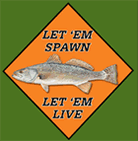Research - Overview
The South Carolina Department of Natural Resources first began stocking red drum in South Carolina waters in 1988 in response to the ASMFC determination that red drum were overfished and undergoing overfishing. While the culture of freshwater fishes in lakes, ponds, and rivers is a practice that began in ancient China nearly 4,000 years ago, the culture and enhancement of marine species is much more recent. Marine stock enhancement is defined as the culture and release of marine organisms with the intent to increase abundance and augment the supply available for harvest or natural reproduction. Stock enhancement in the United States began in the late 1800’s in the Northeast where eggs and larvae of species such as cod, haddock, pollock, and winter flounder were released annually however; the practice was discontinued by the mid-20th century due to an inability of fisheries managers to demonstrate the successful survival and contribution of released fish. By the 1950’s, enhancement of Pacific and Atlantic salmon  was begun on a large scale and by the 1970’s an increased understanding of the early life history of fishes along with technological advances allowed for the mass production of juveniles in a hatchery setting which could be effectively marked and identified in the wild population after release. In the 1980’s and 90’s the SCDNR evaluated the use of stock enhancement as a fisheries management tool for red drum. Today, researchers in South Carolina are refining this tool and expanding its application to additional recreational species such as cobia and spotted seatrout.
was begun on a large scale and by the 1970’s an increased understanding of the early life history of fishes along with technological advances allowed for the mass production of juveniles in a hatchery setting which could be effectively marked and identified in the wild population after release. In the 1980’s and 90’s the SCDNR evaluated the use of stock enhancement as a fisheries management tool for red drum. Today, researchers in South Carolina are refining this tool and expanding its application to additional recreational species such as cobia and spotted seatrout.
Presently, the focus of the South Carolina Department of Natural Resources Marine Stocking Program is on using hatchery produced organisms to answer scientific questions about wild populations while developing the tools and understanding necessary to enhance native populations should they become threatened. The culture, marking , release, and recapture of a candidate species enhances our understanding of life history, reproductive biology and recruitment dynamics as well as movement, population structure, and mortality. The Estuarine Finfish Research section of the SCDNR  Marine Resources Research Institute integrates the fisheries monitoring and genetics disciplines to examine ecological issues such as hatchery contribution, habitat use, carrying capacity, and genetic population structure of target species. The South Carolina Department of Natural Resources Marine Stocking Program is designed to provide fisheries managers with the tools to answer fisheries questions as diverse as the critical winter temperature tolerance of spotted seatrout or the number of broodfish that would be required to ensure genetic diversity in a complete stock restoration project. This information can reduce the uncertainty surrounding management decisions, enable adaptive decision making, and improve the stewardship of South Carolina’s natural resources.
Marine Resources Research Institute integrates the fisheries monitoring and genetics disciplines to examine ecological issues such as hatchery contribution, habitat use, carrying capacity, and genetic population structure of target species. The South Carolina Department of Natural Resources Marine Stocking Program is designed to provide fisheries managers with the tools to answer fisheries questions as diverse as the critical winter temperature tolerance of spotted seatrout or the number of broodfish that would be required to ensure genetic diversity in a complete stock restoration project. This information can reduce the uncertainty surrounding management decisions, enable adaptive decision making, and improve the stewardship of South Carolina’s natural resources.



